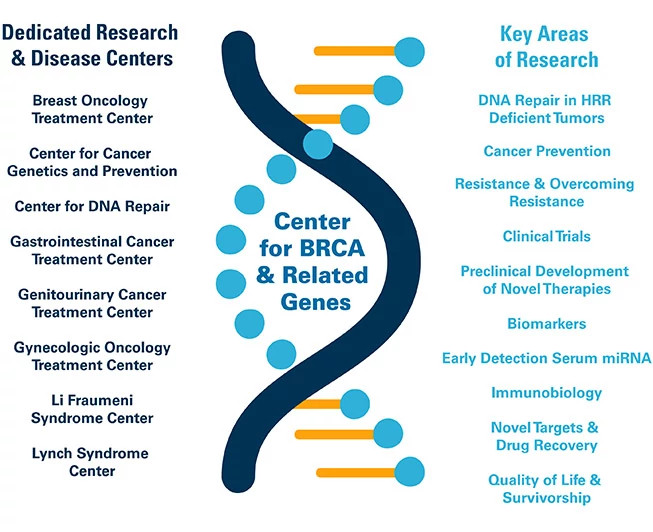Areas of Research Interest
There are three main thematic/focus research areas: Therapy, Risk Reduction (Prevention), and Early Detection. In addition to the BRCA Center's clinical research and clinical trials, our Center is active in all these areas with multiple basic and translational research projects.
Therapy
An important priority of our Center is to develop novel therapies for patients with BRCA-related cancers. In addition, our Center focuses on development of novel biomarkers of response; on development of disease models to test novel therapies preclinically; and on elucidating mechanisms of resistance to these therapies. We are also exploring novel strategies to enhance the activity of immunotherapy in BRCA-mutated tumors by trying to transform immunologically "cold" tumors (tumors that have not been recognized or have not provoked a strong response by the immune system) into "hot" tumors (tumors that have provoked a strong immune response), which are more likely to respond to immunotherapy.
Novel models: A very important area of interest has been the development of novel models of BRCA-related cancers. Examples of such models include:
These models are invaluable platforms for preclinical development of novel therapeutic agents, including novel immunotherapy approaches that can then be tested in clinical trials as discussed below. These platforms also provide the opportunity to study the biology of BRCA-related cancers.
Overcoming resistance: Another focus is on understanding and overcoming resistance to chemotherapy and other targeted therapies. Current studies focus on high-throughput approaches, such as genome-scale CRISPR-Cas9 knockout screens in BRCA-related tumors to gain insight on factors/pathways regulating sensitivity and resistance to specific therapies, as well as small molecule screens to identify agents that can restore therapeutic sensitivity in tumors that are resistant to specific therapies.
Risk Reduction/Prevention
A key priority of our Center, in collaboration with Dana-Farber's Center for Cancer Genetics and Prevention, is to offer novel cancer risk reduction strategies to patients who are carriers of BRCA1/2 mutations and related genes. Our Center focuses on developing and implementing novel systems to expand genetic testing to all who may benefit from the information, based on the most recent guidelines.
Additionally, our Center works with Dana-Farber several investigators to understand the process of carcinogenesis (i.e., how BRCA-mutated and related cancers evolve) and to identify the earliest events using cellular, molecular, and immunologic assays on precursor lesions. Understanding the earliest events in BRCA tumor development may provide novel targets for cancer prevention. Ongoing basic research work focuses on dissecting the DNA repair functions of the BRCA1/2 and other BRCA-related genes and elucidating BRCA regulatory and BRCA-independent DNA repair mechanisms that contribute to the development of breast, ovarian, and other BRCA-related cancers (such as prostate and pancreatic cancers).
Early Detection
A major priority of our Center is early detection, with a focus on ovarian and pancreatic cancers, for which there are currently no reliable and effective screening tests. Dipanjan Chowdhury, PhD, and Kevin Elias, MD, have discovered a specific set of 14 circulating microRNAs (miRNAs) in the serum of ovarian cancer patients that may be used for early detection of the disease. This test has very promising accuracy in detecting ovarian cancer and discriminating from benign ovarian lesions and healthy controls. In collaboration with Judy Garber, MD, MPH, the MiDe Study (MiRNA Detection Study) was opened in the fall of 2019 to systematically examine the specificity and sensitivity of this test in detecting ovarian cancer in asymptomatic BRCA-mutation carriers.
